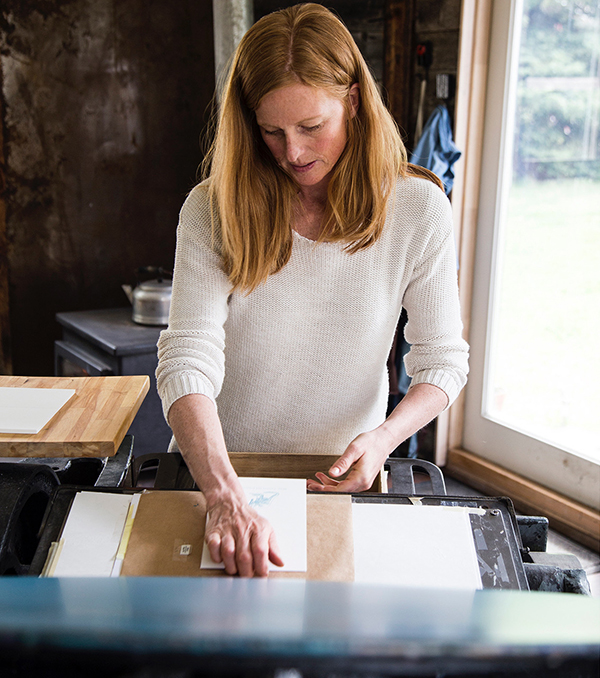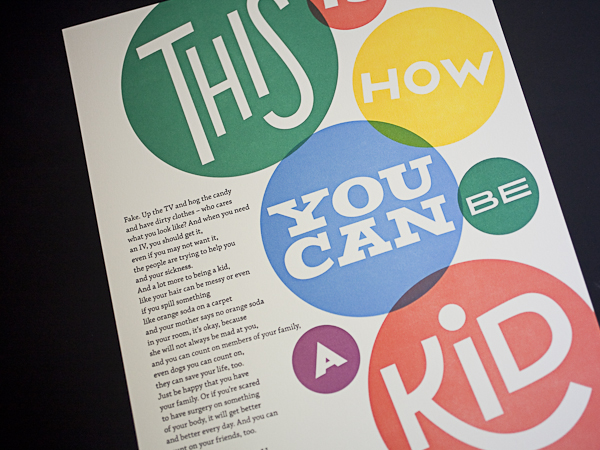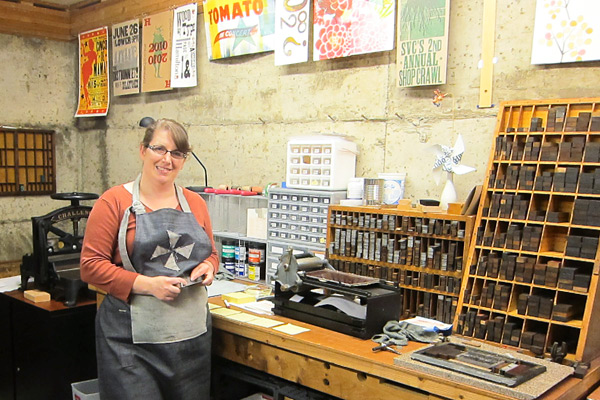The creative trio behind WE ARE 1976 effortlessly combines fun, eclectic, and world-wide inspirations to create hand-made letterpress paper goods in the heart of Dallas, Texas. From punches of color to fun & funky illustrations & prints, the shop is a happy culmination of the team’s love of learning, community printmaking workshops, and the ambition to keep the creative juices flowing. The crew caught us up on eight (and counting!) joyous years honing their craft, incorporating letterpress in their day-to-day lives, and enjoying the rich printing community that surrounds them.

FUNKY + FUN Hello! We’re Vynsie, Jully, and Derek and we own a small shop and letterpress design studio in Dallas, Texas called WE ARE 1976. We opened our shop 8 years ago and we carry handmade and beautifully designed objects (ceramics, jewelry, and home goods) and paper goods (stationery, cards, and prints) from independent makers from all over the world.

About four years ago, we started making our own line of stationery and art prints and have added custom branding, design, and letterpress printing to what we offer. We also teach printmaking workshops and host guest instructors that teach workshops such as calligraphy, water coloring, and jewelry stamping. We all grew up around the Dallas area and love being a part of the creative community here.

FIRST TASTE OF PRINTING Vynsie’s background is in graphic design. She got her first taste of letterpress and antique printmaking techniques at Graham Bignell’s Paper Conservation in London many years ago (cleaning old type cabinets in exchange for press time).

She also worked at Peter Harrington’s Rare Books (at their sister antiquarian print shop, formerly known as Old Church Galleries) which deals in rare books and antique prints made from wood, copper and steel engravings.

We carried the same vision and love of printmaking when we started our business. We have a diverse collection of art prints from illustrators, designers, printers (letterpress and screenprint) from the United States, Europe, Japan and Australia. Dallas also has a really tight letterpress community and we’ve been fortunate enough to get to work with them in various ways – the amazing people at Inky Lips Press, Missing Q Press, Color Box Studio, and Studio 204 were very generous with their time, expertise, and the work they shared in our shop. Five years ago we decided to make letterpress a permanent part of our shop. We started taking more letterpress workshops from places like Punch Press in Austin and San Francisco Center of the Book and with a bit of patience, we were able to locate two presses. We started printing immediately, teaching ourselves and each other.

BIG PRINTS IN TEXAS We moved to our current location because we needed a bigger space to fit our letterpress studio, which takes about half of our shop space. We’re in a charming historic district called The Bishop Arts District in Oak Cliff, Dallas. We’re across the street from a wonderful pie shop, Emporium Pies, and cute shops like Green Pet, Neighborhood, and Wild Detective. Most of the businesses are independently owned and we feel incredibly lucky to be here. There’s also amazing food and drinks on every corner in Oak Cliff – Small Brewpub, Hattie’s, El Si Hay and Spiral Diner. Also, The Texas Theatre is a revitalized theatre with independent programming, fun events, and they host new art exhibitions monthly at their Safe Room gallery.

PRINTING MENTORS One of our presses is from the Art Larson’s Studio Hortan Tank Graphics. When the press was shipped to use, his colleague Joe Riedel came down to help us set up and was invaluable in teaching us the fundamentals of running and operating our presses. And, as mentioned above, we were really encouraged and motivated by many in the Dallas letterpress circle – Casey McGarr of Inky Lips Press, Jason McDaniels of Missing Q Press, Rhona Warren of Color Box Studio and Kim Neiman and Virgil Scott of Studio 204. Also, in our shop, we carry work from other illustrators/printmakers that really inspire us – Daria Tessler, Nate Duvall, Naoshi, Deth P Sun and Kelly Puissegur.
DESIGNERS + PRINTERS We’re both. We’re a family business and work on most projects together whether it’s just exchanging ideas initially or packaging finished projects. It’s so important for us to create unique and beautifully crafted pieces for us and for our clients so there’s lots of discussion and brainstorming before we even start designing or printing. We usually go through a few rounds of roughs and concepts before we get to a finished piece. We have a nice collection of antique type, so we work on many typeset posters, digitally design work, and use Boxcar plates.
FULL TIME FUN With our custom work, own line of stationery and our workshops we’ve been printing full-time for 4 years now. We’re lucky that we have really good team here so if we’re not printing that day, we’re designing something new, or trying to come up with new ideas.

PRINTING FEATS As simple as this sounds, just operating these complex machines is something we’re proud of. Whether it’s just servicing the press, troubleshooting to get the perfect impression, or finding a solution for a squeaky part, learning to trust our instinct with the mechanics of these antique presses while producing beautiful high quality print work brings a new kind of confidence that we don’t get from our normal day-to-day life. We’ve been very proud to do more custom work – wedding invitations, branding projects, personal stationery. All of these moments and projects are important to our our clients and we’re so honored to be a part of it.


PRESS HISTORY Vandercook 325 and Challenge Proof Press. We have added a Vandercook 219 and tabletop Pilot.
BOXCAR’S ROLE Boxcar has made it so much easier for us to create custom work for our clients and for our own line of paper goods. Super helpful with file prep questions and any changes or adjustments.
WHAT’S NEXT Designing and printing more!
An amazingly large round of thanks out to Vynsie + team of WE ARE 1976. Keep up the phenomenal & beautiful letterpress work!






































 The second annual portfolio includes 16 hand-set artist-made letterpress broadsides. WITS Writers-in-residence Sierra Nelson and Ann Teplich worked with patients at the Seattle Children’s Hospital to write the poems, then 16 artists from the Seattle area took the poems and translated them into works of art. The poems were printed as letterpress broadsides and included in a striking red portfolio.
The second annual portfolio includes 16 hand-set artist-made letterpress broadsides. WITS Writers-in-residence Sierra Nelson and Ann Teplich worked with patients at the Seattle Children’s Hospital to write the poems, then 16 artists from the Seattle area took the poems and translated them into works of art. The poems were printed as letterpress broadsides and included in a striking red portfolio.



 UP CLOSE WITH LAURA BENTLEY When I was young I enjoyed doing artsy things, but in college I went a different direction and got a Computer Science and Accounting degree. By day I’m a computer consultant mostly for a dance studio that teaches social dance—ballroom, salsa, and swing. I run their website, set up their sales system, and do their bookkeeping. So, I’m a hobby letterpress printer, and try to squeeze in time to print when I can. I also volunteer as a teaching assistant for the letterpress classes at SVC (School of Visual Concepts) in Seattle.
UP CLOSE WITH LAURA BENTLEY When I was young I enjoyed doing artsy things, but in college I went a different direction and got a Computer Science and Accounting degree. By day I’m a computer consultant mostly for a dance studio that teaches social dance—ballroom, salsa, and swing. I run their website, set up their sales system, and do their bookkeeping. So, I’m a hobby letterpress printer, and try to squeeze in time to print when I can. I also volunteer as a teaching assistant for the letterpress classes at SVC (School of Visual Concepts) in Seattle.


 David Black is a fellow teaching assistant and a print artist. I personally consider him a mechanical genius as he can fix almost anything, and has a real gift for explaining how things work. But what inspires me most is that he makes time to print most every day. He once printed a little card that had a tiny ornament of a car and the text said “Tiny car”; only black ink on white paper. It was a great reminder to me that you don’t always have to be printing big extravagant projects, but can print quick fun things, and you’ll learn something with each new thing you print.
David Black is a fellow teaching assistant and a print artist. I personally consider him a mechanical genius as he can fix almost anything, and has a real gift for explaining how things work. But what inspires me most is that he makes time to print most every day. He once printed a little card that had a tiny ornament of a car and the text said “Tiny car”; only black ink on white paper. It was a great reminder to me that you don’t always have to be printing big extravagant projects, but can print quick fun things, and you’ll learn something with each new thing you print.
 PRESS HISTORY A gentleman named Carl Montford, the self-nicknamed “press matchmaker,” matched me up with an 1863 Gordon Franklin press. It was in the basement of a local artist that wasn’t using it anymore. It’s a great match for me, because it’s a smaller platen press (chase about 7 x 11) and we needed to get it down into my basement. The press would be a little wonky for production work, but it suits a hobby printer like me just fine.
PRESS HISTORY A gentleman named Carl Montford, the self-nicknamed “press matchmaker,” matched me up with an 1863 Gordon Franklin press. It was in the basement of a local artist that wasn’t using it anymore. It’s a great match for me, because it’s a smaller platen press (chase about 7 x 11) and we needed to get it down into my basement. The press would be a little wonky for production work, but it suits a hobby printer like me just fine.